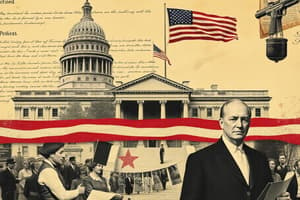Podcast
Questions and Answers
Which branch of government was notably missing in the Articles of Confederation, raising concerns about the potential for a strong federal authority?
Which branch of government was notably missing in the Articles of Confederation, raising concerns about the potential for a strong federal authority?
- Executive branch (correct)
- Judicial branch
- Legislative branch
- Military branch
Under the Articles of Confederation, which entity had the power to tax?
Under the Articles of Confederation, which entity had the power to tax?
- Foreign ambassadors
- State governments (correct)
- Congress
- National courts
What power did Congress have regarding raising money under the Articles of Confederation?
What power did Congress have regarding raising money under the Articles of Confederation?
- Direct taxation authority
- Using national courts to collect taxes
- Selling goods to foreign nations (correct)
- Borrowing from state governments
Which aspect was one of the most significant weaknesses of the Articles of Confederation?
Which aspect was one of the most significant weaknesses of the Articles of Confederation?
What was a key role that state militias played in the defense under the Articles of Confederation?
What was a key role that state militias played in the defense under the Articles of Confederation?
Which entity had the power to appoint foreign ambassadors under the Articles of Confederation?
Which entity had the power to appoint foreign ambassadors under the Articles of Confederation?
Which document established a President as the executive and provisioned for a standing army?
Which document established a President as the executive and provisioned for a standing army?
What was a significant departure in the Constitution from the Articles of Confederation regarding the powers of government?
What was a significant departure in the Constitution from the Articles of Confederation regarding the powers of government?
In contrast to the Articles of Confederation, what power did the Constitution include that was absent in the former?
In contrast to the Articles of Confederation, what power did the Constitution include that was absent in the former?
What did the Constitution aim to prevent by dividing powers into three branches?
What did the Constitution aim to prevent by dividing powers into three branches?
Which document established a more centralized government with clear-cut powers for the federal government?
Which document established a more centralized government with clear-cut powers for the federal government?
What was one key provision included in the Constitution that was not present in the Articles of Confederation?
What was one key provision included in the Constitution that was not present in the Articles of Confederation?
Flashcards are hidden until you start studying
Study Notes
Articles of Confederation vs Constitution: Examining the Powers of Government
Introduction
The Articles of Confederation and the Constitution serve as the cornerstone of American government, each with distinct features and implications. Though both documents recognized the United States of America, they differed in their approaches to the organization of government, particularly with regards to powers of government.
The Articles of Confederation
The Articles of Confederation, America's first constitution, established a national government composed of a Congress that had the power to declare war, appoint military officers, sign treaties, make alliances, appoint foreign ambassadors, and manage relations with Indians. However, it created a very weak central government, leaving most of the power with the state governments. Under the Articles, states, not Congress, had the power to tax. Congress could raise money only by asking the states for funds, borrowing from foreign governments, or selling western lands. There was no provision for national courts.
One of the most significant weaknesses of the Articles of Confederation was its inability to address interstate conflicts and promote economic cooperation. The document relied on state militias for defense, which proved to be ineffective in the face of external threats. Additionally, the Articles lacked an executive branch, raising concerns about the potential for a strong federal authority.
The Constitution
In contrast, the Constitution created a more centralized government with clear-cut powers for the federal government. It established a President as the executive, empowered the government to tax, provisioned for a standing army, and established a common currency. The Constitution also included the power to regulate commerce, which was absent in the Articles.
The Constitution's division of powers into three branches (executive, legislative, and judicial) was a significant departure from the Articles of Confederation's more decentralized structure. This separation of powers was designed to prevent any one branch from becoming too powerful, ensuring a balance of power and a more stable government.
Comparison
The primary difference between the Articles of Confederation and the Constitution lies in their approach to the distribution of powers. The Articles created a loose confederation of sovereign states with a weak central government, while the Constitution established a more centralized government with a strong federal authority.
Conclusion
The Articles of Confederation and the Constitution represent two distinct approaches to the organization of government. While the Articles of Confederation emphasized state sovereignty and decentralization, the Constitution established a more centralized government with clear-cut powers for the federal government. The Constitution's separation of powers and its provision for a strong executive branch have proven to be essential for the effective functioning of American government.
Studying That Suits You
Use AI to generate personalized quizzes and flashcards to suit your learning preferences.




